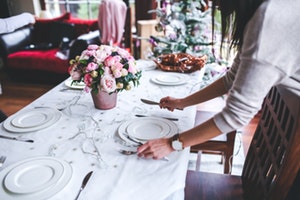
17 Kitchen Skills to Teach in Special Education
By Krystie | Life Skills
None of us can afford to cook with our class or go on CBI's every day.
Some days you just need something that's quick, easy and is going to teach your students some important life skills.
Here’s a list of 17 special education life skills activities that will get your students ready to cook… without cooking.
If you want to increase your students' independence, “beefing” up and focusing on specific skills is the perfect way to get your students ready to finish a recipe. And cooking, without cooking, is the perfect way to achieve that.
Here's how it works.
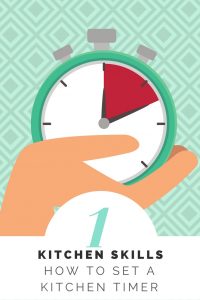
1. How to Set a Kitchen Timer
Most recipes require your students to be able to set a timer, especially anything that’s going into the oven.
So… why not work specifically on teaching your students how to set a timer? You probably have a few timers already lying around your classroom, and I think it’s a good idea to teach them how to use a few different types. Digital, Dial, or Turn are the most common. Below are a few of my favorites, head on over to Amazon to get them now if you don't already have them. I also teach this concept using file folders- sometimes it can be great to give the students hands-on practice without all the noise!
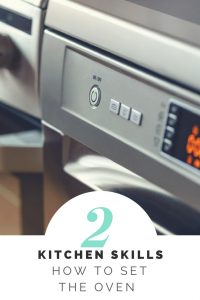
2. How to Set the Oven
Just like setting a kitchen timer, it’s really important to teach your students how to set the oven independently. Many ovens look different. Some are digital, some have turn dials. It’s important to teach how to use both.
If possible it’s nice to get a toaster oven that’s the opposite of the oven you have so you’re able to teach both turn dial and digital. For the classroom, I find that the larger toaster ovens work so much better! Here’s a couple I like…
When we're just get started, I often get out these file folder activities. It's nice to be able to have the whole small group working on one skill, so they're ready when we have a recipe and they need to set the real oven. Set the Oven File Folders Available Here

3. Setting the Stove to a Specific Heat
Most recipes on the stove call for a specific temperature. It says things like… medium, low or medium/high heat.
Often times our stoves are labeled with numbers or not labeled at all. (If yours is old like mine, the numbers peeled off a long time ago.)
To improve your students’ levels of independence, teaching how to turn on and set the stove is a truly important life skill.
- Don’t have a stove? This is also a great activity to do with an unplugged hotplate. It gives the students the hands-on practice without the heat. Plus they can pass it around if you’re doing this activity with the whole class or a small group. Or you can accomplish the same thing with these Set the Stove File Folders.
Hot Plate Suggestion: Cheap and Simple electric hotplate (this is the one I use, it's nothing fancy- but it gets the job done.) Induction hotplate-AMAZING because it never get’s hot to the touch. The pan will… but not the burner itself. (this is the one I lust after 😍)
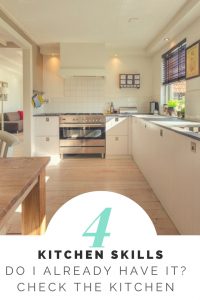
4. Do I Already Have It? Check the Kitchen.
We need to teach our students to check the kitchen first before you buy anything.
I love doing this activity and having my students partner up. We usually do this if we’re headed to the store and will be making something soon. You can also do it as a stand-alone activity using it to build your students familiarity with their classroom kitchen as well as building their kitchen vocabulary.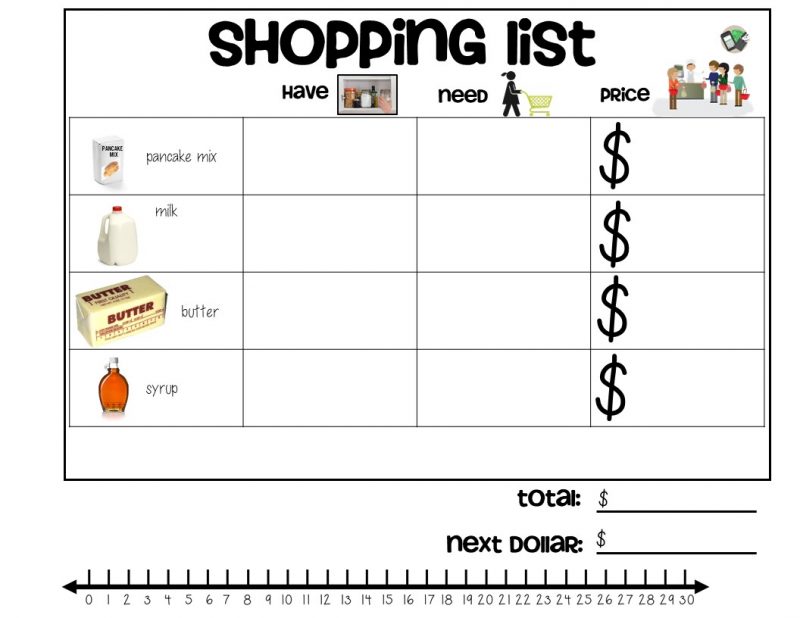
Here's a pic of what I use, but you don't necessarily need anything fancy. As you can see the first step is to check either have or need. Then just send them off in pairs looking for a specified item. (this is also a great way to check their receptive language skills, even something as simple as a fork- it's good to know if they know it.)
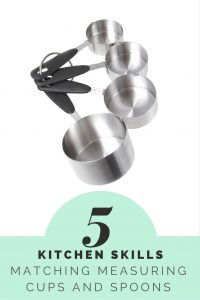
5. Matching Measuring Cups and Spoons
This can be as basic as writing the measurements on 3x5 cards and having your students matching the correct measuring cup/spoon to the label. Or it can be as complicated as having a few recipe cards and having your students look at the recipe to determine which measuring cups/spoons they will need.
If you need to buy some new measuring cups here’s a couple sets I like. Measuring Cup Suggestions: color-coded measuring cups are nice, bright and metal. If you're wanting something with HUGE visuals- this is the set for you.
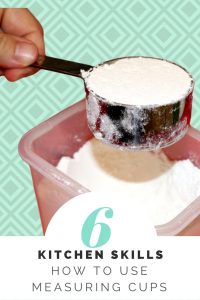
6. How to Use Measuring Cups
Most of our kiddos need a lot of help with this. Just knowing which measuring cup to use isn’t enough. They need to be able to measure their ingredients properly.
Click on the picture to download the visual above for FREE. Then get out some rice or flour and have them start scooping/leveling away.
If you're just getting started- you'll probably need some new measuring cups, please don't just use some old mis-matched sets. It makes it so much harder for your kiddos! Check out this measuring cup set with HUGE visuals. It's a great way to get started.

7. How to Use a Liquid Measuring Cup
I find that liquid measuring cups are always really hard for my students to fill properly. They're always over or under. Getting just to that line is super hard, and usually, takes a bunch of tries.
Over the years I’ve learned that having them fill a cup with the liquid then using the cup to fill the liquid measuring cup is much more successful (especially if they’re trying to get water from the sink, the variable pressure of the sink just makes things a bit too difficult).
Give your students a cup and have them practice filling the cup precisely to the line. This is a great partner activity. My students do a great job of holding each other accountable to filling it to the right spot.
If you're in need of a new set of liquid measuring cups, I like these ones. They're clean and simple to read + they're plastic so you don't have to worry about glass shattering everywhere in the classroom.
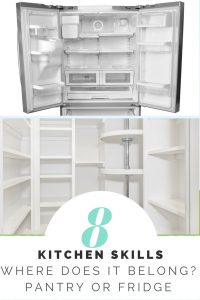
Where Does it Belong? Pantry or Fridge
This is a great activity to do when you get back from a CBI trip and have new groceries.
But, if you don’t have anything on hand you can always just pull up some images online- or have your students provide you with suggestions and then call on someone to tell you where it should go. If you have the physical items have your students put the ingredients away. It's great practice and increases their familiarity with the kitchen.
Sometimes, we don't have enough ingredients or different types of ingredients, and I have students struggling with this concept- that's when I whip out the Where does it belong? Fridge or Pantry File Folders.
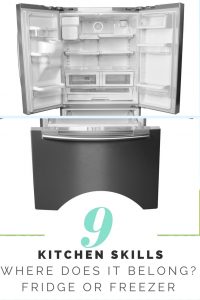
Where Does it Belong? Fridge or Freezer
Same game as above. Just refrigerator/ freezer. This a surprisingly difficult concept for my students. I always find that my kiddos struggle more with this than refrigerator/ pantry. I don't usually have a ton of different refrigerator/ freezer items on hand (especially one's that can sit out) So... I usually get started with file folders, and practice with the real thing whenever we come back from the grocery store.
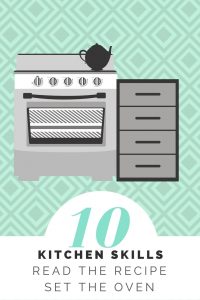
Read the Recipe: Set the Oven
Do you have some extra cookbooks or recipe books just lying around? A great way to use them is to get your students used to looking over a recipe and finding specific information. (remember, we’re all about the baby steps)
Give your students some extra hands-on practice, by having them set the oven dial. If you don’t want them using the real thing during independent work- grab this file folder oven dial set here. Or if you have a counter-top turn dial oven- you can have them practice on an unplugged version during independent work.
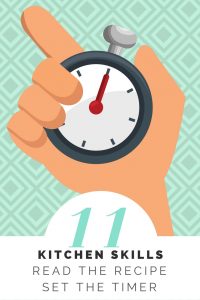
Read the Recipe: Set the Timer
Up the challenge with your timer setting, by having your students look over the recipe and determining what they’ll need to set the timer for.
Especially useful for baking recipes if you’re giving them a cookbook.
- If you don’t have a bunch of extra timers lying around. Or you’re afraid of all the noise it could make distracting your other students. Grab the file folder version here, they’ll still get the hands-on practice without bothering everyone else. Or you can buy a silent vibrating timer, so if it goes off- it isn’t a distraction.
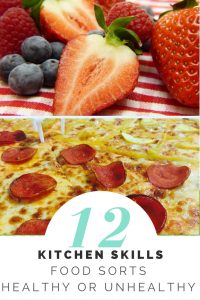
Food Sorts: Healthy or Unhealthy
This is a great independent workstation sorting activity, but in order to get your students started with this idea, it’s a great thing to do in a small group.
Complete with real food, pictures online, or file folders.
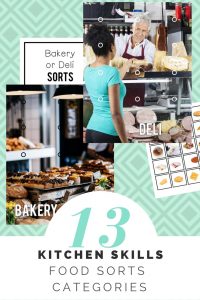
13. Food Sorts into Categories
Categorizing items is something that most of our students find challenging. Is it meat or dairy? A fruit or a vegetable?
Make it hands-on with fake food, or even better use the food you have in your kitchen if you have a bunch of different things.
We don’t usually have a lot of food on hand (we buy what we need for recipes) so, I find that this is a great concept to have your students complete using file folders with real photographs, my students get the idea without us constantly having to buy tons of extra food.

14. Grocery Store Mapping My Route
Once your students are beginning to be able to categorize food- this is a great next step to get them ready to be able to follow a grocery store list and know where to find the necessary ingredients.
Make a list with your students and talk about what sections the ingredients would be found in. Then discuss the best way to make your way through the store. Should you be zig-zagging back and forth, or should you grab all the produce at once? If you're looking for something premade- I have a set that teaches this.
Once they’re doing pretty good with this… try going to the store and have them complete grocery list scavenger hunts.
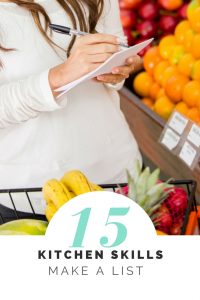
15. Make a List
If your students can read- you can always let them find a recipe that looks good to them and make a grocery store list (having them determine if you already have any of the ingredients is always a great idea)
If your students cannot read independently there are tons of video recipes online that they can find. Or you can write down the list, then have your students attach an image next to it. (this my favorite). Below is a video walking you through the steps. (but, it's basically using google docs, copy/ paste, and inserting images)
Keyboard Shortcuts link.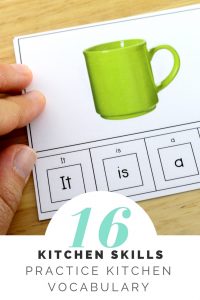
16. Learning Kitchen Vocab...
Kitchen vocabulary is pretty important if you want your students to be able to increase their independence level they’ll need to know the basics by name. You can use adapted books or make it into a game. Make it a game by partnering students up and challenging them to see who can find it first. (you can even give them a few things they need to find to make it more difficult). Or sometimes a simple photograph book is what you need to get started.

17. Set the Table
You can make this as simple as using a “Setting the table” placemat and having your students match the items. Or you can beef it up by looking at recipes and having your students determine what dishes/ utensils they’ll need. If you need a new setting the table placemat- you can get an adorable one here!
Those are all the ways I work on kitchen skills with my students without cooking. Leave a comment below if you have any other ideas you’d like to share, or if you found this list helpful. I'd love to hear what else you do!
-Krystie
AdaptEd 4 Special Ed is a participant in the Amazon Services LLC Associates Program, an affiliate advertising program designed to provide a means for sites to earn advertising fees by advertising and linking to Amazon.





